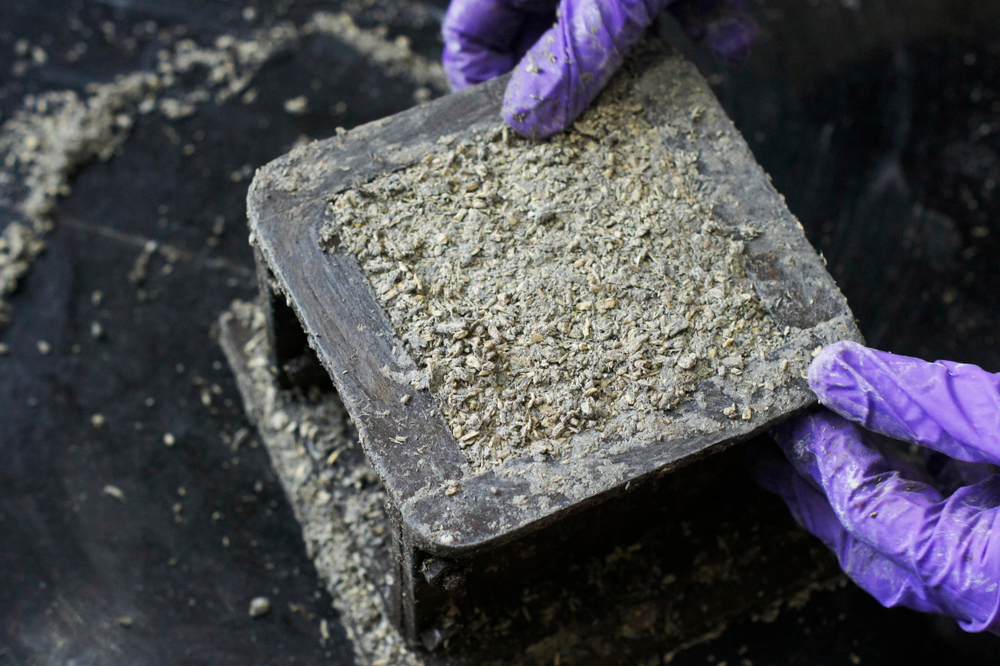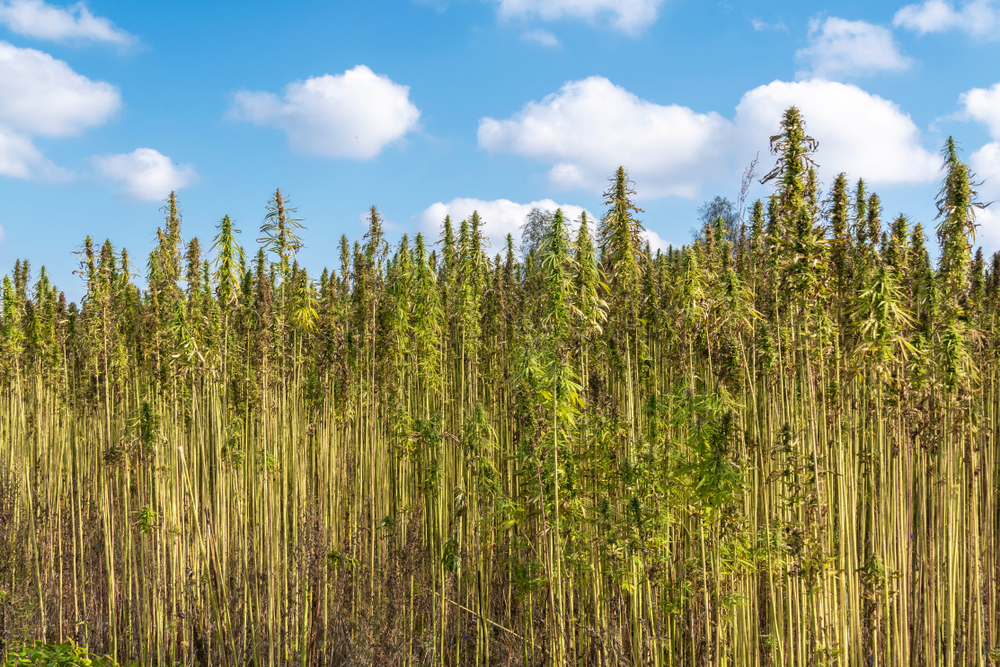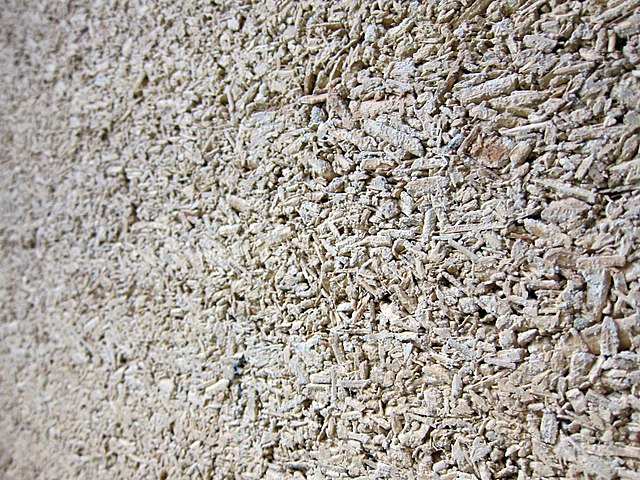Will Hempcrete Ever Catch On?
It’s a dream green building material. Why aren’t farmers interested?
Will Hempcrete Ever Catch On?
It’s a dream green building material. Why aren’t farmers interested?

A fresh mix of hempcrete being cast into a cube mold.by Tarun Jami, Shutterstock.
Hemp mixed with a lime binder makes green builders drool. Called hempcrete, this insulation material resists mold, fire and pests. It lasts forever (or close enough). It absorbs carbon. It’s commonly used in construction in Europe and Canada. With sustainable building materials worth billions of dollars, it has the potential to take off here, too.
But few farmers in the US grow hemp for that purpose. They grow hemp for CBD, for bioplastics, for food and for mulch. They’ll grow hemp for cat litter. But not for hempcrete, which uses a different crop, known as fiber, from the more popular CBD cannabinoid variety that yields CBD. There’s no market to speak of for hempcrete, and therein lies a dilemma.
Farmers need reliable customers and economies of scale. They need to live near a processing center—few facilities exist across the country—or else pay a lot for shipping the product. And few construction professionals have embraced hempcrete because it’s so new to the US and, for now, costs more than traditional products. The rare builders that do work with it generally can’t get enough local hemp. So they import from overseas, especially from Europe, where experience has created consistent quality.
“It’s the chicken and egg,” says Rusty Peterson, a Michigan hemp producer. “Farmers won’t grow at any volume until they have guaranteed processing and a consistent supply chain.”

Hemp is versatile. It can be used for 25,000 different products, including fabrics, bio-fuel and cosmetics. But growing it involves trial and error, seeing that cultivation was only legalized on a national level in 2018. Nearly all the plants under production in the US are of the cannabinoid variant. The stalky fiber type, in contrast, has more industrial applications, including hempcrete. For now, it accounts for a fraction of production, even though it’s easier to farm than the horticultural cannabinoid.
Even those who grow the fiber often steer clear of hempcrete. Take the owners of Eaton Hemp, whose hemp farm was the first in New York to be licensed in 2016. The company quickly forged a niche for snacks and pet bedding, and this year is on pace to quadruple gross profits from 2020 to $1.2 million. It wagered on growing demand for plant-based food and organic goods, rather than create a market that didn’t exist at a price point that’s above what comparable stuff is going for.
“[Producing] hempcrete might be something we look at down the road if it made sense,” says Dan Dolgin, co-founder and CEO of Eaton Hemp. “We probably don’t grow enough here to justify that. For hempcrete to be viable, you’d need tens of thousands of acres to be grown.”
Many farmers burned by a glut in CBD have quit hemp entirely; total licensed acreage has plummeted 44 percent since 2019 to about 285,000 acres as of late September, according to Hemp Industry Daily. Farmers are only slowly pivoting to the fiber option.
Yet the potential is huge. The hardy hemp stalks flourish in diverse soils and climates. Grown in rows like rotational crops such as corn, soybeans and wheat, they can be farmed with existing machinery. Once harvested, the stalks yield three components—seeds, bast (long fibers that work for textiles and plastics) and hurd, the bamboo-like interior that suits building supplies such as particle boards and hempcrete.

But hempcrete has a big barrier: Most building professionals have never worked with it. Some mistakenly think it substitutes for concrete. (Wrong: Hempcrete serves as a filler that cannot bear weight, unless compressed.) They have never cast it in place, the most common application method that is messy and prone to human error. They have never sprayed it, an alternative technique, or estimated the load-bearing potential of prefabricated blocks.
“Most people don’t even know what it is,” says Jacob Waddell, president of the US Hemp Building Association. “Architects, general contractors, regulators. Farmers think it’s something to get high. It’s a very complicated puzzle to educate people.”
Permits are particularly tricky. No national guidelines, test methods or specifications for hempcrete exist. Building codes differ from state to state and even county to county, and approval depends on whether your local official embraces innovation. Many don’t.
To counter that, the Association is trying to establish best practices and rules for acceptance by the International Code Council, the trusted source for standards in the construction industry. It is aiming for next year and hopes that new codes will prompt a groundswell of interest.
That might be too late for Hempitecture, one of the leading American companies working with hempcrete. After spending years focused on hempcrete alone, it’s pivoting toward hempwool, a product replacement for traditional insulation that doesn’t require complicated manufacturing or authorization.
“It’s more viable to sell a product than a system for building,” says Hempitecture CEO and founder Matthew Mead. “Until there is acceptance by the building community, it’s going to be very difficult to sell hempcrete.”
Follow us
This work is licensed under a Creative Commons Attribution-NoDerivatives 4.0 International License.
Want to republish a Modern Farmer story?
We are happy for Modern Farmer stories to be shared, and encourage you to republish our articles for your audience. When doing so, we ask that you follow these guidelines:
Please credit us and our writers
For the author byline, please use “Author Name, Modern Farmer.” At the top of our stories, if on the web, please include this text and link: “This story was originally published by Modern Farmer.”
Please make sure to include a link back to either our home page or the article URL.
At the bottom of the story, please include the following text:
“Modern Farmer is a nonprofit initiative dedicated to raising awareness and catalyzing action at the intersection of food, agriculture, and society. Read more at <link>Modern Farmer</link>.”
Use our widget
We’d like to be able to track our stories, so we ask that if you republish our content, you do so using our widget (located on the left hand side of the article). The HTML code has a built-in tracker that tells us the data and domain where the story was published, as well as view counts.
Check the image requirements
It’s your responsibility to confirm you're licensed to republish images in our articles. Some images, such as those from commercial providers, don't allow their images to be republished without permission or payment. Copyright terms are generally listed in the image caption and attribution. You are welcome to omit our images or substitute with your own. Charts and interactive graphics follow the same rules.
Don’t change too much. Or, ask us first.
Articles must be republished in their entirety. It’s okay to change references to time (“today” to “yesterday”) or location (“Iowa City, IA” to “here”). But please keep everything else the same.
If you feel strongly that a more material edit needs to be made, get in touch with us at [email protected]. We’re happy to discuss it with the original author, but we must have prior approval for changes before publication.
Special cases
Extracts. You may run the first few lines or paragraphs of the article and then say: “Read the full article at Modern Farmer” with a link back to the original article.
Quotes. You may quote authors provided you include a link back to the article URL.
Translations. These require writer approval. To inquire about translation of a Modern Farmer article, contact us at [email protected]
Signed consent / copyright release forms. These are not required, provided you are following these guidelines.
Print. Articles can be republished in print under these same rules, with the exception that you do not need to include the links.
Tag us
When sharing the story on social media, please tag us using the following: - Twitter (@ModFarm) - Facebook (@ModernFarmerMedia) - Instagram (@modfarm)
Use our content respectfully
Modern Farmer is a nonprofit and as such we share our content for free and in good faith in order to reach new audiences. Respectfully,
No selling ads against our stories. It’s okay to put our stories on pages with ads.
Don’t republish our material wholesale, or automatically; you need to select stories to be republished individually.
You have no rights to sell, license, syndicate, or otherwise represent yourself as the authorized owner of our material to any third parties. This means that you cannot actively publish or submit our work for syndication to third party platforms or apps like Apple News or Google News. We understand that publishers cannot fully control when certain third parties automatically summarize or crawl content from publishers’ own sites.
Keep in touch
We want to hear from you if you love Modern Farmer content, have a collaboration idea, or anything else to share. As a nonprofit outlet, we work in service of our community and are always open to comments, feedback, and ideas. Contact us at [email protected].by Judith Matloff, Modern Farmer
December 1, 2021
Modern Farmer Weekly
Solutions Hub
Innovations, ideas and inspiration. Actionable solutions for a resilient food system.
ExploreExplore other topics
Share With Us
We want to hear from Modern Farmer readers who have thoughtful commentary, actionable solutions, or helpful ideas to share.
SubmitNecessary cookies are absolutely essential for the website to function properly. This category only includes cookies that ensures basic functionalities and security features of the website. These cookies do not store any personal information.
Any cookies that may not be particularly necessary for the website to function and are used specifically to collect user personal data via analytics, ads, other embedded contents are termed as non-necessary cookies.
My partner and I am actually starting a hempcrete nonprofit, making tiny homes for homeless/vets/ those effected in natural disasters.
Hope to connect with more people in the industry!
“Some mistakenly think it substitutes for concrete. (Wrong: Hempcrete serves as a filler that cannot bear weight, unless compressed.)”
Perhaps they should rename this product something other than “-crete” in order to reduce the confusion.
Someone’s going to need to go out on a limb and build a large building that uses hempcrete properly, displaying its’ qualities and benefits, before enough will get on the bandwagon. Need to show people the benefits
Hemp fibers can be grown in as little as a few months, compared to pine trees which are grown in 12-15 years. They realized they were able to help save the planet by applying the Italian hemp bedding in their barn.
Kevin McCloud from the Grand Designs TV show in the UK built 42 houses using hempcrete in Swindon about ten years ago. He made a TV show about that project.
Hempcrete can be used be used in if the mixture is changed and use hurd a different way.
We have made Lintels that can hold 3 ton. Tested at UWA in Western Australia
Casadehemptree.org
Interesting article, love it!
but the thermal properties are much better with hempcrete….thus the operating costs over the lifespan of the building are much less.
Hemp wool and any soft material in a wall can be nested in by critters so I don’t see where one has anything to do with the other. hempcrete stands alone, and what it does in building a better home.